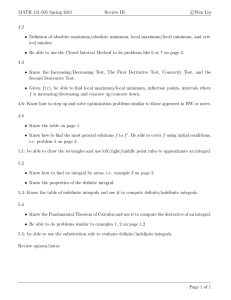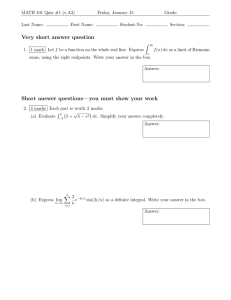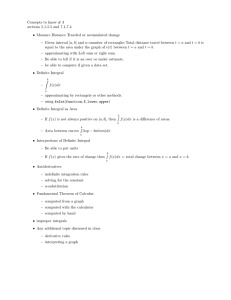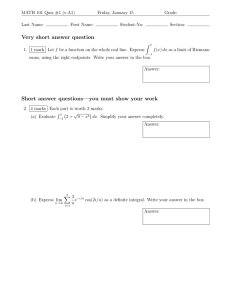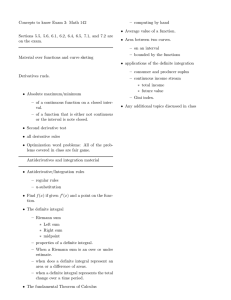Math 105 Week 2 January 10, 2011 1. Lesson plan
advertisement
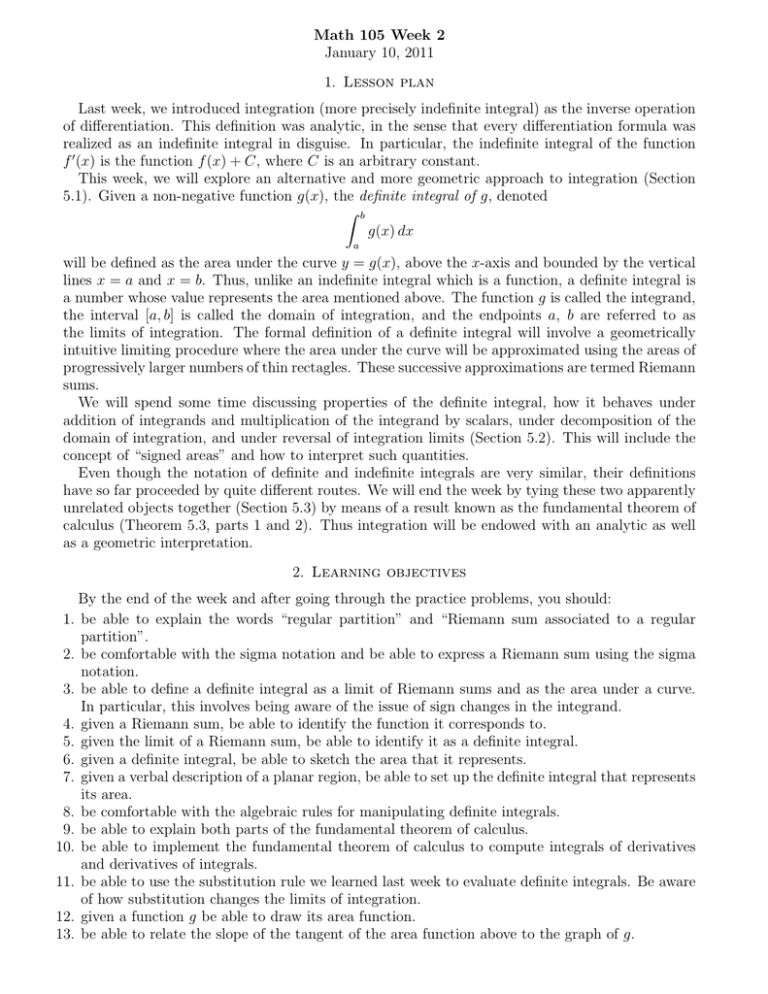
Math 105 Week 2 January 10, 2011 1. Lesson plan Last week, we introduced integration (more precisely indefinite integral) as the inverse operation of differentiation. This definition was analytic, in the sense that every differentiation formula was realized as an indefinite integral in disguise. In particular, the indefinite integral of the function f 0 (x) is the function f (x) + C, where C is an arbitrary constant. This week, we will explore an alternative and more geometric approach to integration (Section 5.1). Given a non-negative function g(x), the definite integral of g, denoted Z b g(x) dx a will be defined as the area under the curve y = g(x), above the x-axis and bounded by the vertical lines x = a and x = b. Thus, unlike an indefinite integral which is a function, a definite integral is a number whose value represents the area mentioned above. The function g is called the integrand, the interval [a, b] is called the domain of integration, and the endpoints a, b are referred to as the limits of integration. The formal definition of a definite integral will involve a geometrically intuitive limiting procedure where the area under the curve will be approximated using the areas of progressively larger numbers of thin rectagles. These successive approximations are termed Riemann sums. We will spend some time discussing properties of the definite integral, how it behaves under addition of integrands and multiplication of the integrand by scalars, under decomposition of the domain of integration, and under reversal of integration limits (Section 5.2). This will include the concept of “signed areas” and how to interpret such quantities. Even though the notation of definite and indefinite integrals are very similar, their definitions have so far proceeded by quite different routes. We will end the week by tying these two apparently unrelated objects together (Section 5.3) by means of a result known as the fundamental theorem of calculus (Theorem 5.3, parts 1 and 2). Thus integration will be endowed with an analytic as well as a geometric interpretation. 2. Learning objectives By the end of the week and after going through the practice problems, you should: 1. be able to explain the words “regular partition” and “Riemann sum associated to a regular partition”. 2. be comfortable with the sigma notation and be able to express a Riemann sum using the sigma notation. 3. be able to define a definite integral as a limit of Riemann sums and as the area under a curve. In particular, this involves being aware of the issue of sign changes in the integrand. 4. given a Riemann sum, be able to identify the function it corresponds to. 5. given the limit of a Riemann sum, be able to identify it as a definite integral. 6. given a definite integral, be able to sketch the area that it represents. 7. given a verbal description of a planar region, be able to set up the definite integral that represents its area. 8. be comfortable with the algebraic rules for manipulating definite integrals. 9. be able to explain both parts of the fundamental theorem of calculus. 10. be able to implement the fundamental theorem of calculus to compute integrals of derivatives and derivatives of integrals. 11. be able to use the substitution rule we learned last week to evaluate definite integrals. Be aware of how substitution changes the limits of integration. 12. given a function g be able to draw its area function. 13. be able to relate the slope of the tangent of the area function above to the graph of g.


